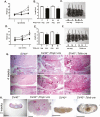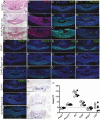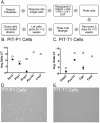Pituitary Tumors and Immortalized Cell Lines Generated by Cre-Inducible Expression of SV40 T Antigen
- PMID: 33837405
- PMCID: PMC8183496
- DOI: 10.1210/endocr/bqab073
Pituitary Tumors and Immortalized Cell Lines Generated by Cre-Inducible Expression of SV40 T Antigen
Abstract
Targeted oncogenesis is the process of driving tumor formation by engineering transgenic mice that express an oncogene under the control of a cell-type specific promoter. Such tumors can be adapted to cell culture, providing immortalized cell lines. To make it feasible to follow the process of tumorigenesis and increase the opportunity for generating cell lines, we developed a mouse strain that expresses SV40 T antigens in response to Cre-recombinase. Using CRISPR/Cas9 we inserted a cassette with coding sequences for SV40 T antigens and an internal ribosome entry site with green fluorescent protein cassette (IRES-GFP) into the Rosa26 locus, downstream from a stop sequence flanked by loxP sites: Rosa26LSL-SV40-GFP. These mice were mated with previously established Prop1-cre and Tshb-cre transgenic lines. Both the Rosa26LSL-SV40-GFP/+; Prop1-cre and Rosa26LSL-SV40-GFP/+; Tshb-cre mice developed fully penetrant dwarfism and large tumors by 4 weeks. Tumors from both of these mouse lines were adapted to growth in cell culture. We have established a progenitor-like cell line (PIT-P1) that expresses Sox2 and Pitx1, and a thyrotrope-like cell line (PIT-T1) that expresses Pou1f1 and Cga. These studies demonstrate the utility of the novel, Rosa26LSL-SV40-GFP mouse line for reliable targeted oncogenesis and development of unique cell lines.
Keywords: PITX1; PROP1; SOX2; adenoma; progenitor; thyrotrope.
© The Author(s) 2021. Published by Oxford University Press on behalf of the Endocrine Society. All rights reserved. For permissions, please e-mail: journals.permissions@oup.com.
Figures







Similar articles
-
Characterization of the recombination activity in the pituitary and ovary of Prop1-iCre knockin mice.Am J Physiol Endocrinol Metab. 2025 Jun 1;328(6):E994-E1000. doi: 10.1152/ajpendo.00049.2025. Epub 2025 May 6. Am J Physiol Endocrinol Metab. 2025. PMID: 40327412
-
Immortalization of pituitary cells at discrete stages of development by directed oncogenesis in transgenic mice.Development. 1996 Oct;122(10):3319-29. doi: 10.1242/dev.122.10.3319. Development. 1996. PMID: 8898243
-
Targeted pituitary tumorigenesis using the human thyrotropin beta-subunit chain promoter in transgenic mice.Mol Cell Endocrinol. 1994 Nov;105(2):147-54. doi: 10.1016/0303-7207(94)90164-3. Mol Cell Endocrinol. 1994. PMID: 7859921
-
SV40 large T antigen directed by regulatory elements of the human alpha-1-antitrypsin gene. A transgenic mouse system that exhibits stages in liver carcinogenesis.Intervirology. 1990;31(2-4):85-100. doi: 10.1159/000150142. Intervirology. 1990. PMID: 2142679 Review.
-
SV40 large T antigen targets multiple cellular pathways to elicit cellular transformation.Oncogene. 2005 Nov 21;24(52):7729-45. doi: 10.1038/sj.onc.1209046. Oncogene. 2005. PMID: 16299533 Review.
Cited by
-
Multi-omic profiling of pituitary thyrotropic cells and progenitors.BMC Biol. 2021 Apr 15;19(1):76. doi: 10.1186/s12915-021-01009-0. BMC Biol. 2021. PMID: 33858413 Free PMC article.
-
Developmental pluripotency-associated 4 increases aggressiveness of pituitary neuroendocrine tumors by enhancing cell stemness.Neuro Oncol. 2025 Jan 12;27(1):123-139. doi: 10.1093/neuonc/noae148. Neuro Oncol. 2025. PMID: 39093695 Free PMC article.
References
-
- Zhu Z, Cui W, Zhu D, Gao N, Zhu Y. Common tools for pituitary adenomas research: cell lines and primary cells. Pituitary. 2020;23(2):182-188. - PubMed
-
- Ahuja D, Sáenz-Robles MT, Pipas JM. SV40 large T antigen targets multiple cellular pathways to elicit cellular transformation. Oncogene. 2005;24(52):7729-7745. - PubMed
-
- Manfredi JJ, Prives C. The transforming activity of simian virus 40 large tumor antigen. Biochim Biophys Acta. 1994;1198(1):65-83. - PubMed
-
- Alarid ET, Windle JJ, Whyte DB, Mellon PL. Immortalization of pituitary cells at discrete stages of development by directed oncogenesis in transgenic mice. Development. 1996;122(10):3319-3329. - PubMed
-
- Lew D, Brady H, Klausing K, et al. GHF-1-promoter-targeted immortalization of a somatotropic progenitor cell results in dwarfism in transgenic mice. Genes Dev. 1993;7(4):683-693. - PubMed
Publication types
MeSH terms
Substances
Grants and funding
LinkOut - more resources
Full Text Sources
Other Literature Sources
Medical
Molecular Biology Databases
Research Materials
Miscellaneous

